
Rođeni kameni u listopadu: Istraživanje opala i turmalina
Rođeni u listopadu imaju dva tradicionalna kamena rođenja: turmalin i opal. Oba jedinstvena dragog kamena imaju prekrasan, raznolik raspon boja i optičkih efekata.
Poput rujna, mjesec listopad je dobio ime od latinske riječi octo , što znači „osam“, zbog svog izvornog mjesta u 10-mjesečnom ranom rimskom kalendaru. Anglosaksonci su listopad nazivali Winterfylleth , što znači „zimski puni mjesec“, jer su vjerovali da zima počinje tijekom punog mjeseca u listopadu.
Jedan zanimljiv rimski listopadski praznik bio je Mundus Patet , gdje su se carstva živih i mrtvih otvarala jedno drugome.
Danas se u listopadu slave slični blagdani poput Dia de Los Muertos i Noći vještica. Listopad simbolizira ispunjenje, žetvu onoga što si posijao i životni ciklus.
Da vidimo odgovara li ta simbolika listopadskim kamenčićima rođenja! Danas ćemo proći kroz svu povijest, svojstva, značenja i upotrebu turmalina i opala kao listopadskih kamenčića rođenja.
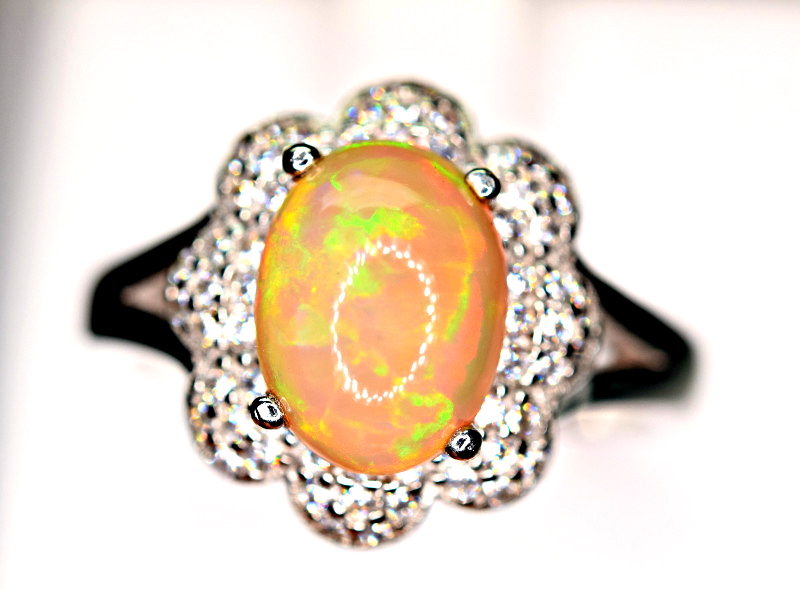 Na gornjoj slici: Prsten s dragocjenim opalom
Na gornjoj slici: Prsten s dragocjenim opalom
Povijesno i kulturno značenje kamenja rođenja u listopadu
Koji je službeni kamen rođenja za listopad? Postoje dva službena poludraga kamena označena kao kamen rođenja za listopad: opal i turmalin .
Ali zašto postoje dva kamena rođenja za listopad? Pa, nisu uvijek bila dva.
Prvi popisi kamenja rođenja, nastali od 1. do 5. stoljeća poslije Krista i inspirirani biblijskim popisima dragog kamenja, kao kamen rođenja za listopad naveli su beril (ili konkretno akvamarin).
Moderni formalizirani popisi započeli su 1870. godine, kada je Tiffany & Co objavio brošuru „Gregorijanske pjesme o kamenu rođenja“. Pjesma iz listopada bila je o opalu.
Prvi standardizirani popis došao je od Nacionalnog udruženja draguljara (sada Jewellers of America) 1912. godine, koji su odredili opal kao primarni kamen rođenja u listopadu, a turmalin kao alternativu.
Pedesetih godina prošlog stoljeća, Vijeće američke industrije nakita izmijenilo je popis iz 1912., imenujući ružičasti turmalin kao listopadsku alternativu.
Najnovija američka lista iz 2016. godine ima opal i ružičasti turmalin kao jednake prioritete za listopad. Britanska lista iz 2013. godine sadrži samo opal.
Iznenađujuće, dva dragulja koja odaju počast „mračnom i sablasnom“ mjesecu listopadu uglavnom su ukorijenjena u predaji vezanoj uz dugu.
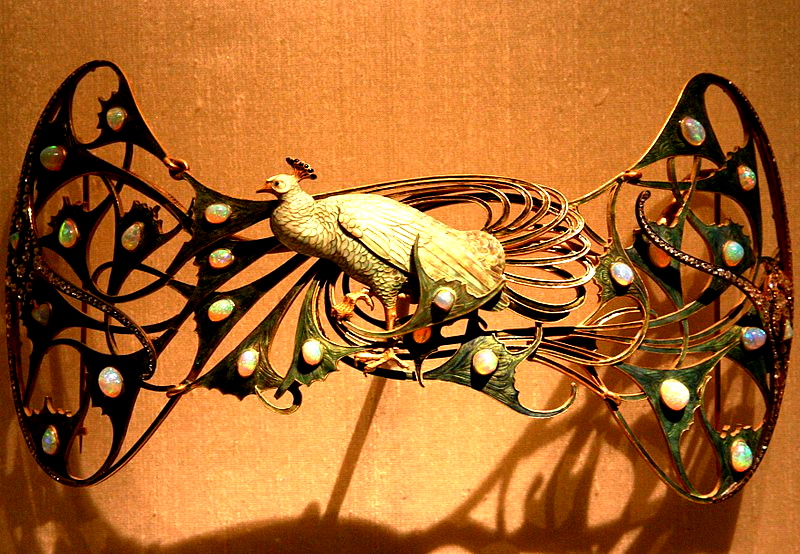 Na gornjoj slici: René Lalique (1860.-1945.); Ornament u obliku korža u obliku pauna, oko 1898.-1900. sa zlatom, opalima, dijamantima i emajlom; Muzej Calouste Gulbenkian | Autor slike: © José Luiz Bernardes Ribeiro / CC BY-SA 3.0
Na gornjoj slici: René Lalique (1860.-1945.); Ornament u obliku korža u obliku pauna, oko 1898.-1900. sa zlatom, opalima, dijamantima i emajlom; Muzej Calouste Gulbenkian | Autor slike: © José Luiz Bernardes Ribeiro / CC BY-SA 3.0
Mitsko podrijetlo opala i drevni folklor
Stari Grci vjerovali su da opali nastaju od suza radosnica koje je prolio bog neba Zeus nakon pobjede nad Titanima.
Stari Rimljani su opal smatrali kraljicom dragulja. Jedan rimski učenjak, Plinije Stariji, pisao je o opalima koji imaju sve najbolje kvalitete drugih vrijednih dragulja poput rubina , smaragda i ametista .
Priča o opalu kod starosjedilaca Australije (ponekad nazvana "aboridžinska") datira stoljećima unatrag.
Jedan mit o podrijetlu opala je o Duginoj zmiji , moćnom biću koje je letjelo između rupa s vodom, a njegove prelijevajuće ljuske padale su na zemlju kao opali.
Drugi australski mit o podrijetlu opala kaže da je predački duh Stvoritelja otišao na Zemlju putujući dugom, a opali su se pojavili tamo gdje su im stopala dodirnula tlo.
Drevni indijski mit kaže da je Božica Majka pretvorila Djevicu Božicu Duge u opal kako bi joj pomogla pobjeći od neželjenih naklonosti više bogova koji je progone.
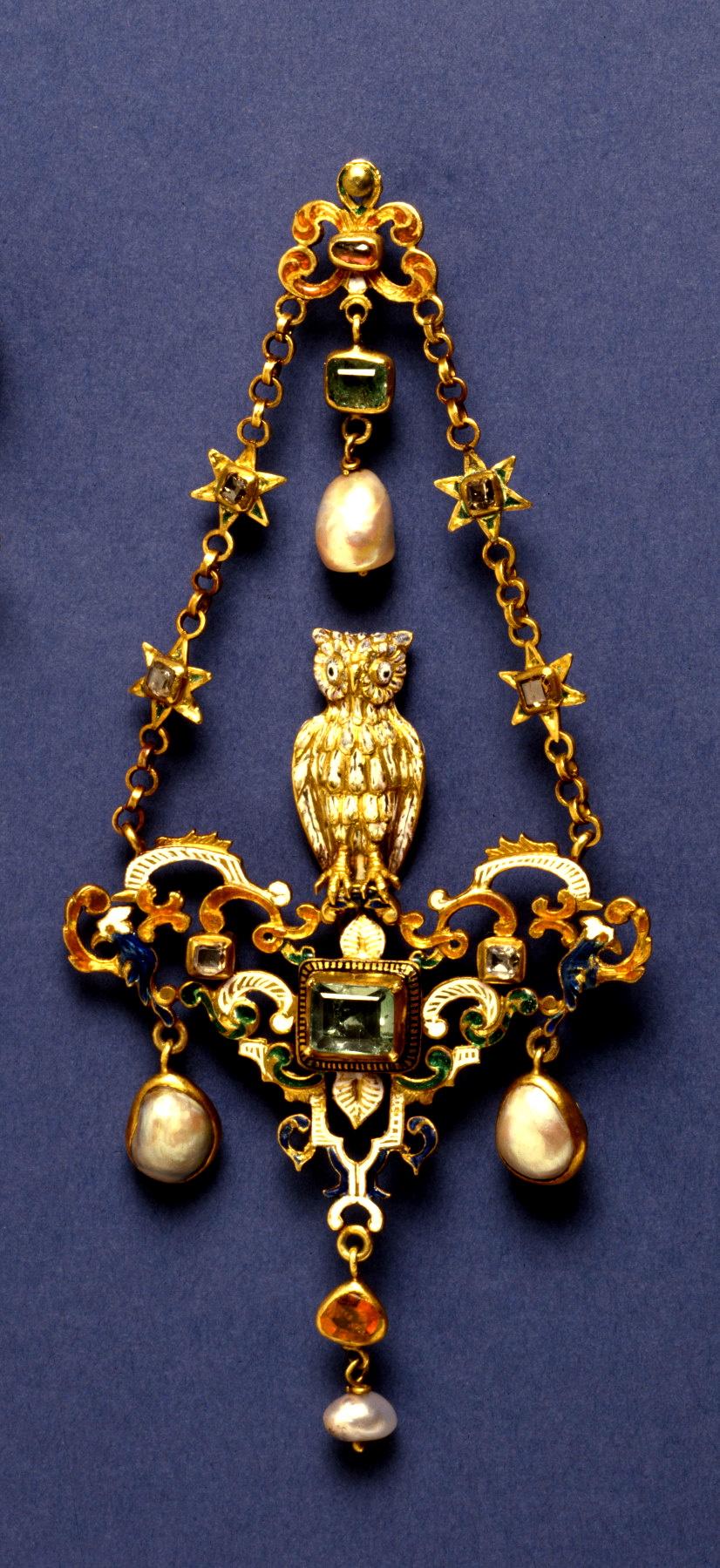 Na gornjoj slici: Zlatni privjesak sove s turmalinom, rubinom, dijamantom i biserom; Datira iz 19. stoljeća, prije se smatralo da potječe iz 16. stoljeća; Izloženo u Muzeju umjetnosti Walters | Autor slike: Muzej umjetnosti Walters, Javna domena
Na gornjoj slici: Zlatni privjesak sove s turmalinom, rubinom, dijamantom i biserom; Datira iz 19. stoljeća, prije se smatralo da potječe iz 16. stoljeća; Izloženo u Muzeju umjetnosti Walters | Autor slike: Muzej umjetnosti Walters, Javna domena
Raznolike povijesne veze turmalina
Turmalin ima nešto kraću povijest od opala, ali je jednako fascinantan.
Naziv ovog listopadskog kamena dolazi od singalske (šrilankanske) riječi turmali, što znači "mješovito drago kamenje". Nizozemski trgovci skovali su naziv za šareno kamenje u paketima dragulja sa Šri Lanke.
Nizozemska trgovina "schorlom" (crnim turmalinom) datira barem iz 15. stoljeća, ako ne i ranije.
Još jedno povijesno otkriće turmalina dogodilo se 1554. godine. Španjolski konkvistador Francisco Spinoza pronašao je zeleni turmalin u Brazilu koji je nazvao "brazilskim smaragdom".
Još jedna značajna pogrešna identifikacija turmalina je " Cezarov rubin ", crveni kamen čija povijest među francuskom i ruskom kraljevskom obitelji seže u 16. stoljeće. Otkriveno je da je rubelit turmalin 1920-ih.
Zapravo, trgovci su vjerojatno nazivali obojene turmaline drugim dragim kamenjem sve dok prva vrsta (schorl) nije analizirana 1785. godine. Vrsta nije bila u potpunosti prepoznata sve do otkrića bora 1808. godine.
Nakon što je turmalin otkriven u Kaliforniji 1892. godine, velik dio ružičastog turmalina u državi prodan je kineskoj carici udovici Tz'u Hsi, koja je favorizirala ovaj dragulj.
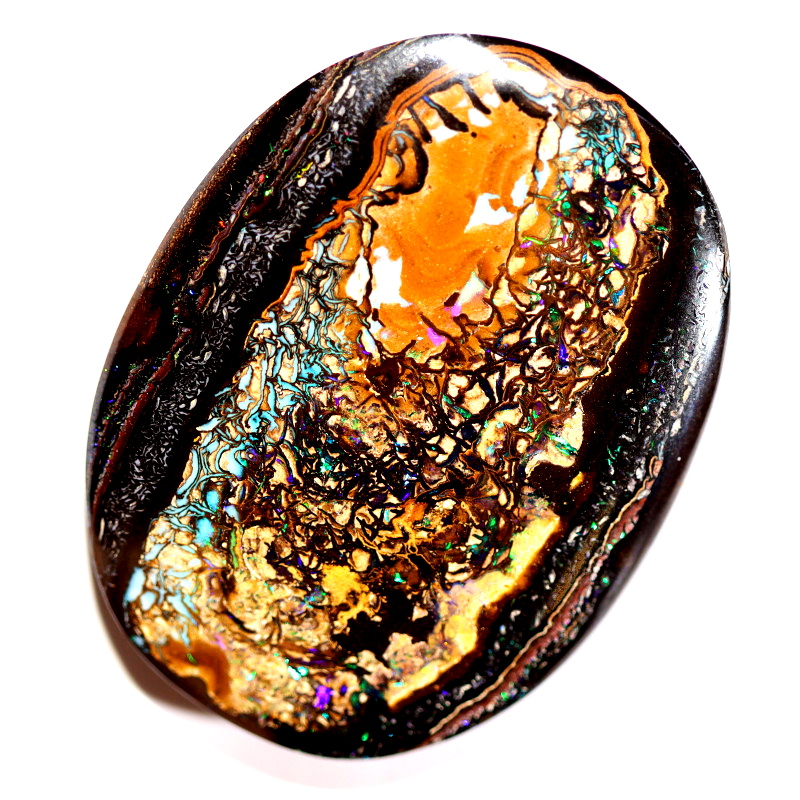 Na gornjoj slici: Polirani matrični opal
Na gornjoj slici: Polirani matrični opal
Geološko čudo: Nastanak opala i turmalina
Počevši od opala , ovi dragulji su amorfni mineraloidi , bez kristalne strukture. Sastoje se od silicija i različitog udjela vode.
Opal nastaje kada se voda koja sadrži otopljeni silicijev dioksid taloži u području poput pukotine željeznog kamena ili riolitne geode („jaje groma“). Kada voda ispari, gel se stvrdnjava u opal.
Dragulj se također može formirati oko fosila poput drevnih morskih stvorenja (npr. opal belemnit) ili drveta.
Ali opal je također i svemirski kamen ! Opali su pronađeni na Marsu i 2015. i 2023. godine , što dokazuje da planet sadrži vodu.
Rođendanski kamen turmalin iz listopada formira se donekle slično.
U vrlo dubokim, visokotemperaturnim hidrotermalnim naslagama, turmalin nastaje kada se voda koja sadrži otopljeni bor i silicijev dioksid taloži u pukotinama magme. Magma se postupno stvrdnjava u stijenu, voda isparava, a elementi kristaliziraju.
Lokacije rudarstva
Oko 95 posto svjetskog dragocjenog opala dolazi iz Australije.
Većina turmalina dolazi iz Brazila ili zemalja Afrike. Kalifornija u SAD-u poznata je po svom ružičastom turmalinu.
 Na gornjoj slici: Obični narančasti vatreni opal, fasetiran
Na gornjoj slici: Obični narančasti vatreni opal, fasetiran
 Na gornjoj slici: Dragocjeni opal iz Lightning Ridgea u Australiji koji pokazuje živopisnu igru boja
Na gornjoj slici: Dragocjeni opal iz Lightning Ridgea u Australiji koji pokazuje živopisnu igru boja
Opalove razigrane boje: Otkrivanje unutarnje čarolije
Najšire kategorije opala su obični opal i plemeniti opal .
Sastav opala, kamena rođenja za listopad, sastoji se od silicijevih kuglica okruženih vodom. Ako su kuglice neorganizirane i nejednakih veličina, dobivate obični opal. Kuglice ujednačene veličine i rasporeda (poput Buckyballa) rezultiraju plemenitim opalom.
Samo „dragocjeni opal“ pokazuje igru boja , gdje s njegove površine bljeskaju iridescentne boje.
NAPOMENA: Neki gemolozi koriste „igru boja“ kao sinonim za „ opalescenciju “. Drugi definiraju opalescenciju kao mliječni ili gotovo biserni izgled nekih uobičajenih opala.
Različite vrste opala uglavnom se kategoriziraju prema tonu tijela (boji pozadine), prozirnosti i igri boja.
Glavne vrste tjelesnih tonova opala su bijeli opal , sivi opal i crni opal . Razlikuju se pomoću tablice tjelesnih tonova .
Opali s drugim bojama tijela uključuju:
Ljubičasti Morado opal
Vatreni opal (crveni, narančasti i/ili žuti)
Bezbojne varijante opala uključuju kristalni opal , kontraluz opal i žele opal . Hijalitni opal može biti bezbojan. Hidrofanski opal postaje proziran i bezbojan u vodi.
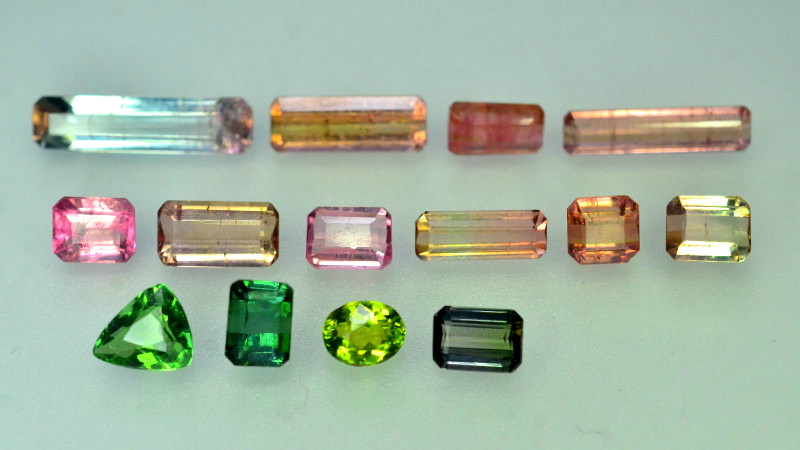 Na gornjoj slici: Razne boje i varijante fasetiranih turmalina
Na gornjoj slici: Razne boje i varijante fasetiranih turmalina
Mnoga lica turmalina
„Turmalin“ je zapravo složena, raznolika skupina od preko 30 minerala. Najčešće vrste su:
Schorl : Najčešća vrsta, oko 95 posto svih prirodnih turmalina; smeđe do crne boje
Dravit : Relativno čest; Nadimak "smeđi turmalin", ali može biti i drugih boja
Elbait : Najčešća vrsta draguljarske kvalitete, najpoznatija i najvrjednija; Može biti gotovo bilo koje boje ili višebojna
Svaka vrsta može proizvesti sorte s različitim bojama. Najčešće prodavane sorte turmalina:
Crni turmalin : Samo schorl varijanta; najčešći turmalin; uvijek neproziran
Krom turmalin : dravit; rijetka jarko zelena boja
Indiolit : Elbait; Pretežno plava boja
Paraiba turmalin : Elbait; Intenzivno zasićena neonskoplava do plavozelena ili ljubičasta boja
Rubelit : Obično elbait; Zasićena ružičasta do rubin-crvena varijanta, mogući ljubičasti, smeđi ili narančasti podtonovi
Verdelit : Elbait; Zelena sorta često nazivana "brazilskim smaragdom" ili "cejlonskim peridotom "
Lubenični turmalin : Elbait; Dvobojan, ružičasto-zelen, obično s ružičastim središtem i zelenim rubom, ponekad odvojen bezbojnim slojem.
Siberit : Elbait, ponekad smatran podvrstom rubelita; Nadimak "ljubičasti turmalin" iako je obično crvenkasto-ljubičaste ili ljubičasto-crvene boje.
Ružičasti turmalin, kamen rođenja, je varijanta elbaita, često spada u rubelit ili siberit. Višebojne opcije uključuju ružičasti i zeleni turmalin boje lubenice te ružičasti i narančasti "turmalin boje zalaska sunca".
Najrjeđa vrsta turmalina je turmalin Paraíba. Čisto žuti, narančasti, plavi, ljubičasti ili turmalini koji mijenjaju boju također su rijetki.
Drugi faktor je pleokroizam , zbog kojeg je turmalin cijenjen. Primjerci koji pokazuju snažan pleokroizam imaju veću vrijednost.
Kad smo već kod vrijednosti, kako se ocjenjuju kamenčići rođeni u listopadu?
 Na gornjoj slici: Fasetirani turmalin lubenice
Na gornjoj slici: Fasetirani turmalin lubenice
Procjena kvalitete: Karakteristike opala i turmalina
Određivanje vrijednosti turmalina je mnogo jednostavnije od opala. U nastavku ćemo se usredotočiti na standardne faktore vrijednosti dragog kamenja - boju, brus, čistoću, težinu u karatima i tretmane - i za opal i za turmalin. Više o tome kako se ocjenjuje vrijednost opala možete saznati ovdje .
Boja
Opal : Glavni faktori vrijednosti za ove rodne kamenje su boja opala (boja tijela) i prisutnost igre boja. Najčešća boja opala prema tonu tijela je bijela, zatim siva i zelena. Najrjeđi je crni ili crveni. Općenito, dragocjeni opali su mnogo vrijedniji od običnih opala.
Najbolja igra boja ima bljeskove crvene (ili svake boje), prikazuje jedinstvene uzorke i prekriva cijelu površinu kamena. Tamniji primjerci poput dragocjenih crnih opala pokazuju svjetliju igru boja, što im povećava vrijednost.
Turmalin : Najrjeđi i najvrjedniji turmalin u boji listopadskog kamena rođenja je paraiba turmalin. Crni, crveni i ružičasti turmalini su češći. Svijetlo zeleni i plavi pleokroizam, parti-color ili svojstva promjene boje mogu povećati vrijednost kamena rođenja.
Rez
Opal : Opali se ne fasetiraju tako često kao drugi dragulji - jedina uobičajena fasetirana vrsta je vatreni opal. Najčešće ćete vidjeti opale izrezane u kabošone ili perle. Igra boja je najbolja kod prozirnih do neprozirnih opalnih kabošona ili potpuno prozirnih fasetiranih opala. Mnogi opalni kabošoni su kompoziti, poput opalnih dubleta ili tripleta .
Turmalin : Dragulji turmalina često su fasetirani, često s dugim pravokutnim oblicima. Briljantni rezovi mogu se odabrati za vrijednije varijante poput turmalina Paraiba. Turmalini s velikim udjelom čestica često se izrađuju u kabošone ili rezbarije, dok se dvobojno kamenje može rezati na kriške.
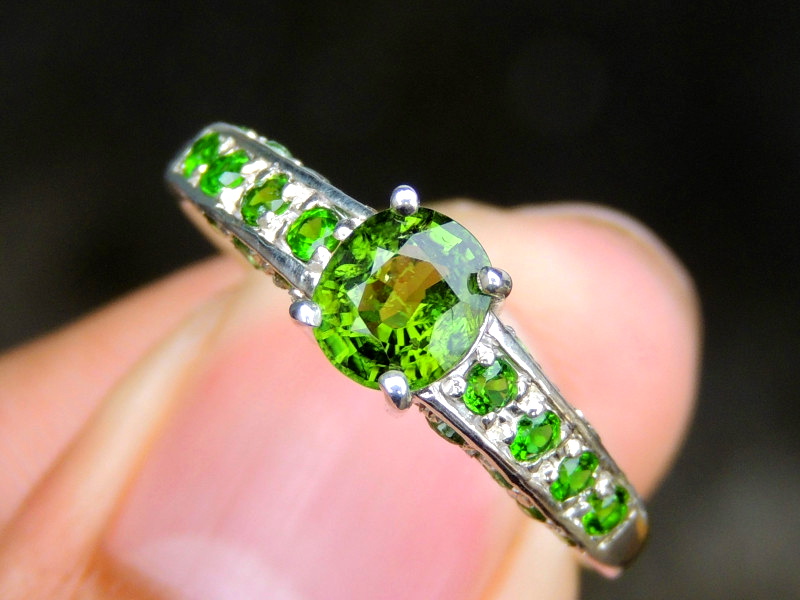 Na gornjoj slici: Fasetirani prsten s kromiranim turmalinom
Na gornjoj slici: Fasetirani prsten s kromiranim turmalinom
Jasnoća i transparentnost
Jasnoća opisuje stupanj vidljivih inkluzija u kamenu, što smanjuje njegovu prozirnost i vrijednost.
Opal : Inkluzije općenito smanjuju vrijednost opala. Neke inkluzije i dodatni materijal oko opala dovode do različitih varijanti poput dendritičnog opala , matričnog opala i kamenog opala .
Potpuna prozirnost je rijetka i vrijedna kod opala, iako su crni opali bolje neprozirni. Zamućenost obično smanjuje vrijednost.
Turmalin : Većina turmalina ima čistoću tipa II , što znači da se očekuju manje vidljive inkluzije. Kromirani i zeleni turmalini su tipa I (obično bez inkluzija), dok su paraiba, rubelit i turmalin boje lubenice tipa III (uvijek vidljivo uključeni).
Vidljivije inkluzije i niža prozirnost znače turmalin niže vrijednosti. Jedina inkluzija koja povećava vrijednost je prisutnost poravnanih cijevi koje uzrokuju cat-oyancy (efekt „mačjeg oka“).
Sam turmalin je inkluzija u turmaliranom kvarcu .
Težina u karatima
Opal : Rjeđi opali poput crnog ili kristalnog opala mogu imati skokove cijene po karatu u intervalima kao što su 1-5 karata, 5-10 karata i 10+ karata.
Turmalin : Turmalini rođeni po rođenju variraju u veličini, ali dragulji iznad 5 karata su skuplji. Raznolikost je također važna - kromirani turmalin se obično nalazi do 5 karata, ali paraiba turmalin rijetko je veći od 1 karata.
Tretmani
Opal : Neobrađeni opali su znatno vrijedniji od obrađenih, posebno rijetke vrste poput crnog opala. Ovdje možete naučiti kako testirati tretmane opala ili odnijeti svoj listopadski kamen u laboratorij kako biste potvrdili.
Turmalin : Tretmani će također smanjiti vrijednost turmalina, ali su uobičajeni kod ovog listopadskog kamena rođenja. Uobičajeni tretmani (često za poboljšanje boje ili jasnoće) uključuju zračenje , toplinu i/ili punjenje pukotina.
 Na gornjoj slici: Privjesak od australskog crnog opala
Na gornjoj slici: Privjesak od australskog crnog opala
Značenja i kulturna uvjerenja o rođenju u listopadu
Koje je duhovno značenje listopadskih kamenja rođenja? Osim što su oba dragulja povezana s dugama, svaki ima svoju jedinstvenu simboliku i mistična svojstva.
Značenja opala
Prema drevnim tumačenjima, opali simboliziraju čistoću, nadu i perspektivu. Rimljani su opale nazivali Cupid paederos ili „dijete lijepo kao ljubav“.
Iako su opali u 19. stoljeću privremeno bili obojeni praznovjerjem o prokletstvu , mnoga drevna društva poput Kine vjerovala su da opali donose sreću. Jedno uobičajeno praznovjerje koje i dalje postoji jest da je nesretno za svakoga tko nije rođen u listopadu nositi opal.
Kao ljekoviti kamen , mnoga navodna svojstva opala vrte se oko vida i uma. Vjeruje se da ljekovite moći ovog listopadskog kamena uključuju liječenje problema s vidom, poboljšanje kognitivnih sposobnosti i omogućavanje da vidite budućnost.
Značenja turmalina
Sveukupno, turmalin, kamen rođenja za listopad, simbolizira suosjećanje, otvorenost uma i oprost. Ponekad se naziva i "kamenom pomirenja".
Svaka boja turmalina ima svoje značenje i ljekovita svojstva. Fokusirajući se na ružičasti turmalin, kaže se da ovaj listopadski dragulj pojačava energiju, potiče ljubav i pomaže u ublažavanju problema u vezama.
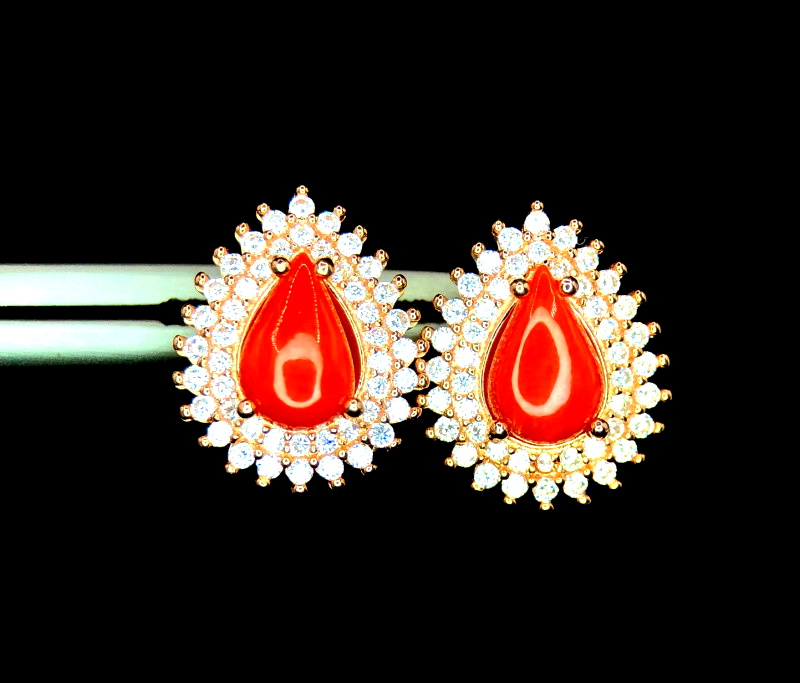 Na slici gore: Naušnice od crvenog koralja
Na slici gore: Naušnice od crvenog koralja
Alternativni kamenčići rođenja za listopad
Koji je najpopularniji kamen rođenja za listopad? Opal je obično "klasik", popularniji izbor od turmalina, ali postoje i drugi kameni i kristali rođeni za listopad!
Popularne alternative kamenju rođenja za listopad su beril i koralj .
Astrološki, koji je kamen rođenja za Vagu ? Vage rođene u rujnu (nakon 23.) mogu imati koristi od peridota, ružičastog kvarca i morganita .
Što je s kamenjem rođenim za Škorpione ? Škorpioni rođeni u rujnu (prije 23.) mogu iskoristiti crni turmalin, malahit i koralj.
Personalizirani pokloni s kamenom rođenja za listopad
Imate dragulj, što sad učiniti s njim? Izvrstan poklon od kamena rođenog u listopadu dolazi iz srca i slavi vašu voljenu osobu rođenu u listopadu.
Budući da je listopad jedan od najčešćih mjeseci za vjenčanja, prsten s rođendanskim kamenom iz listopada odličan je način za proslavu!
Možete čak nabaviti i nakit po narudžbi, poput ogrlice s kamenom rođenja za listopad s dizajnom nevena, cvijeta rođenja tog mjeseca.
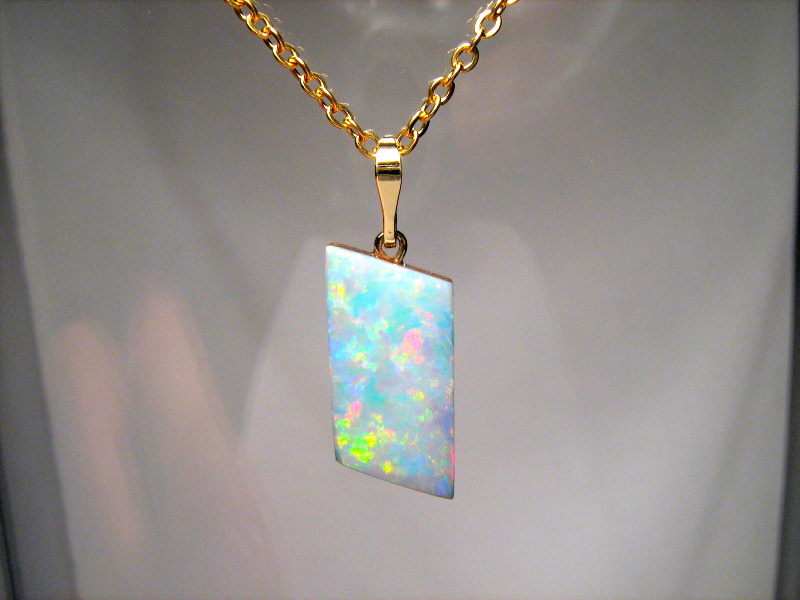 Na gornjoj slici: Ogrlica s privjeskom od bijelog dragog opala
Na gornjoj slici: Ogrlica s privjeskom od bijelog dragog opala
Presretni zbog kamenja rođenja u listopadu?
I turmalin i opal su omiljeni zbog svog raspona boja i jedinstvenog izgleda. Preferirate li nedavno formalizirani ružičasti turmalin, stariji tradicionalni opal ili neki drugi kamen rođen u listopadu? Slijedite svoje srce i odaberite koji vam dragulj odgovara!
Pronađite tradicionalno i alternativno kamenje za rođenje u listopadu među stotinama dostupnih dragog kamenja ili pregledajte naš opsežan izbor opala na Opal Auctions .
Pretražite Gemstone Encyclopedia
Povezane aukcije
povezani članci
Svatko ima dragi kamen koji odgovara njegovom horoskopskom znaku. Poznati su i kao vaš Zvjezdani Kamen. Saznajte više o ovom kamenju i saznajte koji je vaš Zvjezdani Kamen.
10th May 2018
Izvorno su se kamenje rođenja ili drago kamenje povezivali sa horoskopskim znakom ili mjesecom rođenja osobe. Saznajte koji je vaš kamen i pogledajte kamenje koje imamo na prodaju.
8th Feb 2021
Na tržištu postoji toliko mnogo alata za testiranje dragog kamenja, ali koji su glavni alati potrebni za jednostavnu analizu? Pogledajmo četiri alata za testiranje dragog kamenja.
4th Mar 2020
Najnoviji članci
Rezbarije od palmine slonovače, također nazvane biljna slonovača, prirodna su alternativa slonovoj slonovači, etički ubranoj s palminog oraha južnoameričke palme fitelefas. Saznajte sve o palminoj slonovači u ovom vodiču!
15th Jan 2026
Krizanteme su prirodna čuda s cvjetnim uzorkom bijelog kalcita, celestita ili andaluzita naspram crnog vapnenca ili muljevca.
13th Jan 2026
Sunčev kamen s duginom rešetkom je vrsta feldspata s tri prekrasna optička efekta uzrokovana prisutnošću raznih inkluzija. Njegov vatreno šareni prikaz i uzorak rešetke čine ga rijetkim kolekcionarskim draguljem!
12th Jan 2026
Kategorije članaka
How To's is where you will find helpful articles from gem Rock Auctions on how to cut gemstones, select gemstones and buy gemstones.
9 Članci




